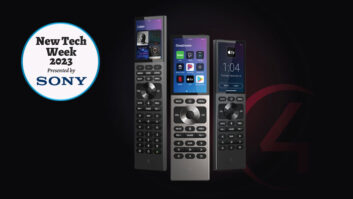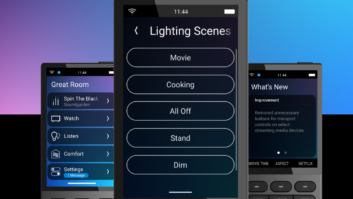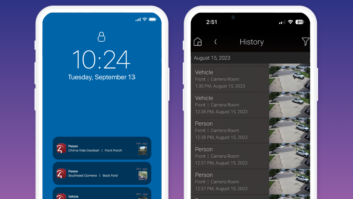My task was simple, contact the industry’s top executives and ask them to predict the future of the custom integration industry. But the task for these executives was not simple. Even though it was the beginning of a new year, we weren’t asking about their expectations for 2017—no, we wanted their thoughts on 2022…five years into the future.

Martin Plaehn
Seventeen brave souls agreed to give it a shot. One executive was particularly impressive with his clear, detailed, nuanced vision of what he calls “the journey” that the industry is taking to the future: Martin Plaehn, CEO of Control4 Corporation. Plaehn’s vision touched on several key structural elements of the industry that are in the process of changing…or evolving. One year ago, Control4 acquired networking company Pakedge, and the company clearly recognizes networking as a central element to just where this industry is heading.
Here, then, are some key quotes pulled from a long telephone interview about Plaehn’s vision of The Journey to 2022…
On the Connected Home—It Will Happen, Both Types of Them…
Plaehn was unequivocal in his belief that there will be a widespread emergence of the connected home. “The connected home is going to happen. It’s not going to be less connected than it is today. Humans and families and households and equipment—everything with a battery or power—is going to be network aware.”
Plaehn said that there will be two types of connected homes: “In the loosely coupled connected home, a bunch of devices on a network and a bunch of apps do cool things for themselves,” he explained. “In the orchestrated connected home, a sets of devices, if not all of them, work together much like an orchestra does.”
Asked if he was describing the difference between the do-it-yourself market and professional installation, Plaehn said that how the technology got installed wouldn’t be the primary divider. “It becomes a question of…are devices autonomous and have their connected app, either local on the network or through the cloud and sit side by side with other devices not knowing that the other devices are there? Or, are they orchestrated, and they know about each other, in some higher-order way, with regard to their context in that home? They could be DIY and they could be professionally installed.”
For example, Plaehn added: “My professionally installed heating and air conditioning system has a thermostat with a smart app. My new 21st century water heater is network aware and comes with an app, and I didn’t install it. My door locks…maybe a handyman did it…maybe I did it. But I think the method of installation is not necessarily the primary differentiator in this world order that I’m talking about, with loosely coupled connected homes and orchestrated connected homes.”
On the Residential Network – Our Biggest Problem, Our Biggest Opportunity…
“Both of them [loosely coupled connected homes and orchestrated connected homes] are going to require better networks,” Plaehn said. “And for us at Control4, we started out in the orchestrated connected home. We found a real need for better networking, [so] we bought a networking company [Pakedge]. We’re investing hard in smarter and smarter networking—both from a wired standpoint and a wireless standpoint—to handle all the different types of connected home traffic.
“If you pull [the types of connected home traffic] apart, there’s low latency, bi-directional traffic, voice over IP, videoconferencing, Skyping, gaming, intercom between your front door and your house (or room-to-room)—that’s all multimedia based with audio and video. That’s rich media moving back and forth in both directions at 200 milliseconds or 100 milliseconds—you know, bi-directional response—so that it’s fluid interactivity.
“Then you’ve got all the streaming media. You’ve got the prioritization of security cameras competing with your streaming media, and you’ve got your web and app content and interaction. And then you have sensor data that has to be absolutely immediate…I mean instantaneous. If there’s a trigger of a smoke alarm or a fire alarm or water sensor, all that stuff has to traffic. And we take that for granted, but when these networks get saturated, some of these things get compromised. Everybody’s network needs to get more robust, and that’s a big opportunity.”
On Network Construction and Configuration…
With such heavy demand on wired and wireless home networks due to rapidly increasing data traffic, how should integrators approach designing and configuring this network backbone of their system installations? “So, do you build networks and configure them in homes for peak traffic? Or do you build them for a basic or moderate load and then have intelligence that shifts between them?” Plaehn asked rhetorically. “We think that the intelligent network is probably the long-term durable way. So when people are watching streaming media in the household at certain hours, then our network biases itself toward quality of service toward those. If somebody starts looking at a video surveillance camera, [the network] knows that’s way more important—it prioritizes it higher than someone watching Netflix.”
On the Need for Remote System Monitoring Services…
“[Home networks need] to be remotely managed and monitored, because most consumers aren’t going to do this themselves,” Plaehn said. “Yes, we have to make our systems more robust. Yes, we have to make them self-configuring. But, after our second year of marriage, we don’t paint bedrooms with our spouse either. I mean, we outsource that stuff. This stuff [home technology] is way more complicated than a paint bucket and a roller.
“So there will be local specialists that can help you over the phone, or help you login, or be remotely tethered to your home and give you a report that says: ‘You know, we noticed that your home network traffic is rising and rising, and we think that within a few months, if you add two more devices to your home, you’re going to need a more powerful network, or you’re going to have to augment your network.’ There’s no mechanism like that. Because everything we do is going to be network-aware for either the benefit of the end customer—the homeowner and their family—or for the benefit of the manufacturer. This is the journey. This connected world is coming. How are we going to deal with it?”
On the Difference Between Connected Infrastructure and Consumer Electronics…
“Most of us grew up when our homes were dumb,” Plaehn said. “All infrastructure—plumbing, electrical, lighting, heating, garage doors, doors, windows, security systems, cameras—all of that was basically dumb. All of that now is going to get smart.
“When an infrastructure item in your home breaks, you get it fixed. When a consumer electronics product breaks, you throw it away. There’s a big mental difference, even though they both live in this connected home.
“This is all a journey that certain companies have to figure out. At Control4 we’re committed to the connected home. Our customers are homeowners—families with great income—and they love their homes. We provide a connected experience that we believe is part of the infrastructure of their home, not a consumer electronic product. It’s a BIG conceptual difference.”
On Interfaces and Artificial Intelligence…
Then there’s the interface to all of these products. Is it graphical? Is it push-button? Is it voice? Does it anticipate your needs? Plaehn explained that the connected home has two types of interactions: “those that we humans ask the system to do via pressing a button, or a menu, or giving it a voice command, and those that it does on its own because it senses, ‘Hey, it’s 80 degrees outside, it’s 78 degrees inside, the temperature came up from 74 degrees…it’s sunny, the west-facing shades are open. Why don’t we lower those so that we insulate the home from solar energy…so that the house doesn’t cook,’ whether you’re at home or not.
“We sort of do that today, but that can get a lot smarter. And that can get smarter through learning, [and] through programming. Today, that programming is mostly done through specialists, but what about using voice input to convey preference to the system? I mean we all have logic in our head, and we all know how to communicate it in our English language, but most of us don’t know how to convey that in some sort of computer programming language.
“The voice might be a way to do that. Use natural language as an instructive set of preferences or guidance to the underlying system. And that’s a way to convey…to transfer the personalization of somebody’s connected home from the specialist to them. Get the homeowner involved in their connected home because it’s an extension of themselves.”
On Control4’s Commitment to Home Technology Professionals…
“I’m not saying that it’s not an industry responsibility to make these products easier to install and more straightforward for a homeowner, or tech savvy homeowner, or a hobbyist…we should do that,” Plaehn said. “But we shouldn’t be so binary [to] say [that] the only way this is going to happen, the only way this is going to be mass market. Because [consumers] don’t do it themselves. They don’t even cut their own lawn themselves. Think about the infrastructure around your home and how many service providers you have for different aspects of your home. Are you going to change your own garage door? Have you ever done that? That’s the scariest thing in your life. I would advise not doing it, because that spring will take your arm off. So I just think that providers of the connected home, certain classes of product, and certainly companies like us that have sophisticated network offerings and sophisticated orchestrated connected home offerings and solutions…we’re unequivocal and unconflicted. We are building a powerful, professional, certified, local, highly responsive service, and delivery channel of independent companies. We want them in every major city around the world and we want them to be specialists in different aspects of the connected home.”
On How Much of His Vision of the Connected Home Happens in the Next Five Years…
“Oh I think big pieces of it [will be achieved],” Plaehn said. “I definitely think networking will be far more pervasive, far more powerful, and far more intelligent. I think that natural language processing—both being able to speak more naturally for multiple commands or multiple actions; [and] I think that the conveyance of preference with natural language, so that a consumer can customize their home, is certainly doable. I think that having smarter monitoring of connected homes so that a consumer’s trusted specialist—like their gardener, but that is for their home—can know that their home is running well. So that as we approach the Fourth of July weekend, they can make sure that stuff goes great and that the weekend’s activities aren’t spoiled because the connected home is down…or some aspect of it [is down]…
“It’s the journey…it’s the commitment to that type of path. A lot can happen in five years.”






